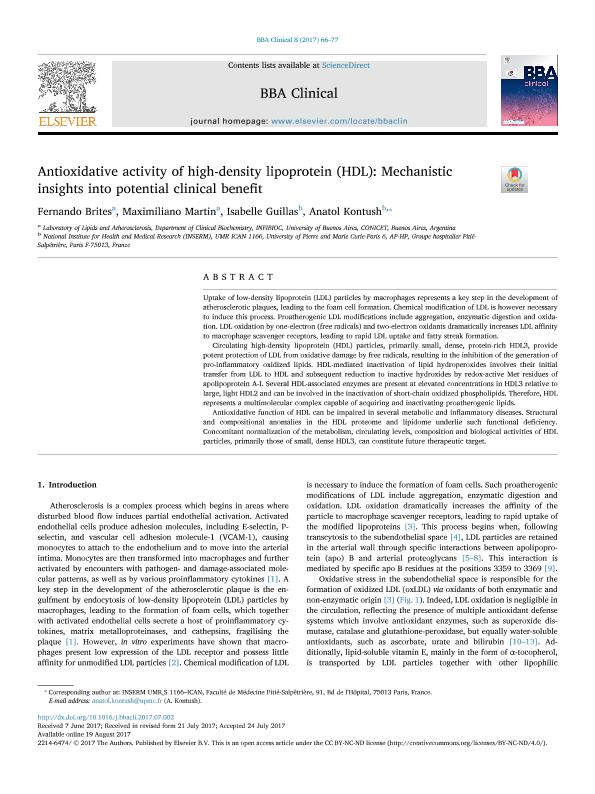Mostrar el registro sencillo del ítem
dc.contributor.author
Brites, Fernando Daniel

dc.contributor.author
Martin, Maximiliano Emanuel

dc.contributor.author
Guillas, Isabelle
dc.contributor.author
Kontush, Anatol
dc.date.available
2018-06-22T20:01:09Z
dc.date.issued
2017-12-19
dc.identifier.citation
Brites, Fernando Daniel; Martin, Maximiliano Emanuel; Guillas, Isabelle; Kontush, Anatol; Antioxidative activity of high-density lipoprotein (HDL): Mechanistic insights into potential clinical benefit; Elsevier; BBA Clinical; 8; 19-12-2017; 66-77
dc.identifier.issn
2214-6474
dc.identifier.uri
http://hdl.handle.net/11336/49754
dc.description.abstract
Uptake of low-density lipoprotein (LDL) particles by macrophages represents a key step in the development of atherosclerotic plaques, leading to the foam cell formation. Chemical modification of LDL is however necessary to induce this process. Proatherogenic LDL modifications include aggregation, enzymatic digestion and oxidation. LDL oxidation by one-electron (free radicals) and two-electron oxidants dramatically increases LDL affinity to macrophage scavenger receptors, leading to rapid LDL uptake and fatty streak formation. Circulating high-density lipoprotein (HDL) particles, primarily small, dense, protein-rich HDL3, provide potent protection of LDL from oxidative damage by free radicals, resulting in the inhibition of the generation of pro-inflammatory oxidized lipids. HDL-mediated inactivation of lipid hydroperoxides involves their initial transfer from LDL to HDL and subsequent reduction to inactive hydroxides by redox-active Met residues of apolipoprotein A-I. Several HDL-associated enzymes are present at elevated concentrations in HDL3 relative to large, light HDL2 and can be involved in the inactivation of short-chain oxidized phospholipids. Therefore, HDL represents a multimolecular complex capable of acquiring and inactivating proatherogenic lipids. Antioxidative function of HDL can be impaired in several metabolic and inflammatory diseases. Structural and compositional anomalies in the HDL proteome and lipidome underlie such functional deficiency. Concomitant normalization of the metabolism, circulating levels, composition and biological activities of HDL particles, primarily those of small, dense HDL3, can constitute future therapeutic target.
dc.format
application/pdf
dc.language.iso
eng
dc.publisher
Elsevier

dc.rights
info:eu-repo/semantics/openAccess
dc.rights.uri
https://creativecommons.org/licenses/by-nc-nd/2.5/ar/
dc.subject
Hdl
dc.subject.classification
Salud Ocupacional

dc.subject.classification
Ciencias de la Salud

dc.subject.classification
CIENCIAS MÉDICAS Y DE LA SALUD

dc.title
Antioxidative activity of high-density lipoprotein (HDL): Mechanistic insights into potential clinical benefit
dc.type
info:eu-repo/semantics/article
dc.type
info:ar-repo/semantics/artículo
dc.type
info:eu-repo/semantics/publishedVersion
dc.date.updated
2018-06-13T15:21:25Z
dc.journal.volume
8
dc.journal.pagination
66-77
dc.journal.pais
Países Bajos

dc.journal.ciudad
Amsterdam
dc.description.fil
Fil: Brites, Fernando Daniel. Consejo Nacional de Investigaciones Científicas y Técnicas. Oficina de Coordinación Administrativa Houssay. Universidad de Buenos Aires. Facultad de Farmacia y Bioquímica. Departamento de Bioquímica Clínica.
Laboratorio de Lípidos y Artroesclerosis; Argentina
dc.description.fil
Fil: Martin, Maximiliano Emanuel. Consejo Nacional de Investigaciones Científicas y Técnicas. Oficina de Coordinación Administrativa Houssay. Universidad de Buenos Aires. Facultad de Farmacia y Bioquímica. Departamento de Bioquímica Clínica.
Laboratorio de Lípidos y Artroesclerosis; Argentina
dc.description.fil
Fil: Guillas, Isabelle. Universite Pierre et Marie Curie; Francia. Inserm; Francia
dc.description.fil
Fil: Kontush, Anatol. Universite Pierre et Marie Curie; Francia. Inserm; Francia
dc.journal.title
BBA Clinical
dc.relation.alternativeid
info:eu-repo/semantics/altIdentifier/doi/https://dx.doi.org/10.1016/j.bbacli.2017.07.002
dc.relation.alternativeid
info:eu-repo/semantics/altIdentifier/url/https://www.sciencedirect.com/science/article/pii/S2214647417300326
Archivos asociados
